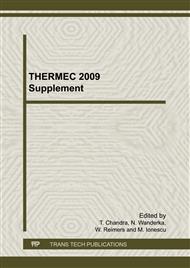p.431
p.437
p.443
p.449
p.455
p.461
p.467
p.473
p.479
Long-Term Corrosion Resistance of Biomedical Grade Stainless Steel ISO 5832-1 ("316LVM") under External Anodic Electrical Pulsing Conditions
Abstract:
For medical implant application of metals or alloys, one major prerequisite is the absence of release of metal ions to the surrounding tissue. In the case of stainless steel, this prerequisite can be achieved by modifying the surface by chemical and electrochemical passivation pre-treatments so that the general corrosion-rate will be reduced and pitting corrosion will not occur. In a first step, the surface of the test specimens (10 mm diam.) were chemically pre-treated with nitric acid using different concentrations and duration. In the second step, the passivation effect was tested by applying voltage-scans reaching from hydrogen to oxygen evolution in a 3-electrode CV-measurement using phosphate buffered saline (PBS) (pH7.4) as electrolyte. It turned out that after the 2nd of a total of five scans all CV-diagrams looked almost the same and the chemical passiva-tion treatment was of minor effect; none of the CV-diagrams showed effects of pitting corrosion. The third step was to apply external electrical anodic pulses (n=5.3x106) on the surface of the specimen (+4.5V, 0.5ms, 740Hz). In the forth step, the passive behaviour again was tested using the same CV-measurement setup. Again, no effect of pitting corrosion was seen and in parts of the CV-diagrams the measured current signal was less than before.
Info:
Periodical:
Pages:
455-460
Citation:
Online since:
January 2010
Authors:
Price:
Сopyright:
© 2010 Trans Tech Publications Ltd. All Rights Reserved
Share:
Citation:


